Supreme Commander-in-Chief of the Russian Armed Forces
The Supreme Commander-in-Chief of the Armed Forces of the Russian Federation (Russian: Верховный главнокомандующий Вооружёнными силами Российской Федерации) is the ultimate commanding authority of the Russian Armed Forces, an executive role vested in the President of Russia in accordance with Article 87 of the Constitution.
| Commander-in-chief role | |
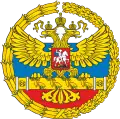 Official emblem | |
.jpg.webp) | |
| Russian Armed Forces | |
| Vested in | President of Russia |
|---|---|
| Style | Comrade Supreme Commander |
| Status | Ultimate commanding authority |
| Residence | Kremlin Senate |
| Seat | Moscow |
| Constituting instrument | Article 87 of the Constitution of Russia |
| Precursor | Supreme Commander of the Soviet Armed Forces |
| Formation | 7 May 1992 |
Legal basis
.jpeg.webp)

On May 7, 1992 Russian President Boris Yeltsin issued a decree №467 "On taking office, the Supreme Commander of the Armed Forces of the Russian Federation".[1] Powers of the President, as Commander In Chief, assigned by the Law of the Russian Federation of December 9, 1992 № 4061-I "On changes and amendments to the Constitution of the Russian Federation".[2] On December 25, 1993 the current Constitution of Russia entered into force, which confirmed the status of the President as the Supreme Commander-in-Chief.
Powers
In accordance with Article 83 of the Constitution of the Russian Federation Supreme Commander-in-Chief:
- Approves military doctrine of the Russian Federation
- Appoints and dismiss the Supreme Command of the Armed Forces of the Russian Federation.
.jpg.webp)
In accordance with Article 4 of the Federal law "On Defense" Supreme Commander-in Chief has a power to:
- Determine the main directions of military policy of the Russian Federation;
- Provide guidance to the Armed Forces of the Russian Federation, other troops, military formations and bodies;
- In the case of aggression or direct threat of aggression against the Russian Federation or the emergence of armed conflict against the Russian Federation, Supreme Commander-in-Chief announces general or partial mobilization, announces martial law on the territory of the Russian Federation or in particular areas of Russian Federation and notifies the Federation Council and the State Duma immediately and issues a decree on the conduct of military operations;
- Enact regulations of war and cease their action, form and abolish executive authorities for a period of war in accordance with federal constitutional law on martial law;
- In accordance with federal laws, make the decision on bringing the Russian Armed Forces, other troops, military formations and bodies to carry out tasks with the use of weapons, not by their intended use;
- Approve:
- the concepts and plans for the construction and development of the Russian Federation Armed Forces, other troops, military formations and bodies;
- the Plan of the Russian Armed Forces;
- mobilization plan of the Armed Forces of the Russian Federation;
- plans for the transfer (mobilization plans) of work of public authorities of the Russian Federation, bodies of state power of subjects of the Russian Federation, local self-government and the economy during the wartime;
- plans to create reserves wealth of state and mobilization reserves;
- federal government program for operational equipment in the Russian Federation for purposes of defence;
- Approve federal government programs of weapons and the development of defense industrial complex;
- Approve nuclear programs and other special tests, and authorizes these tests;
- Approve a single list of military posts to be filled by senior officers in the Armed Forces of the Russian Federation, other troops, military formations and bodies, and the total number of military posts to be filled by colonels (captains 1st rank) in the Armed Forces of the Russian Federation, other troops, military formations and bodies, confers high military ranks, appoint personnel to the military posts, for which the state provides the higher ranks of officers, freeing them from their military posts and dismiss them from military service in the manner prescribed by federal law;
- Approve the structure of the Armed Forces of the Russian Federation, other troops, military formations up to and including associations and bodies, as well as the number of staff members of the Armed Forces of the Russian Federation, other troops, military formations and bodies;
- Make decision on the deployment and redeployment of the Armed Forces of the Russian Federation, other troops, military formations from the link above;
- Approve military regulations, the regulations of the battle flag of the military, naval ensign of the Russian Federation, the order of military service, military councils, the military police stations, military transport duties;
- Approve the regulations of the Ministry of Defence and the General Staff of the Armed Forces of the Russian Federation, as well as provisions on the management bodies of other troops, military formations and bodies;
- Approve regulations on territorial defense and civil defense plan;
- Approve plans to deploy in the Russian Federation with nuclear warheads, as well as facilities for the elimination of weapons of mass destruction and nuclear waste;
- Negotiate and sign international treaties of the Russian Federation in the field of defense, including treaties of mutual defense, collective security, the reduction and limitation of armed forces and armaments, on the participation of the Russian Armed Forces in peacekeeping and international security;
- Issue decrees on conscription of Russian Federation citizens for military service, military training (with the number of recruits Russian citizens and their distribution between the Russian Federation Armed Forces, other troops, military formations and bodies), as well as dismissal from the military service of citizens of the Russian Federation of passing military service in the manner prescribed by federal law;
- Limit the number of members of the Armed Forces of the Russian Federation, other troops, military formations and bodies on secondment to the federal authorities;
- Exercise other powers in the field of defense, entrusted to him by the Constitution of the Russian Federation, federal constitutional laws, federal laws and laws of the Russian Federation.
Symbols
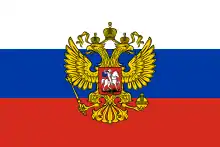
September 21, 1995 Minister of Defence of the Russian Federation approved a sketch of the flag of the Commander-in-Chief of the Armed Forces of Russia. The flag follows the pattern of the Standard of the President of the Russian Federation, but has a 2:3 aspect ratio.[3] The flag is raised on the ships of the Russian Navy when the Supreme Commander is on board. On May 5, 2009, Russian President Dmitry Medvedev has established an official emblem of the Supreme Commander-in-Chief.[4]
List
| No. | Supreme Commander-in-Chief | Took office | Left office | Time in office | Defence branch | |
|---|---|---|---|---|---|---|
| 1 | Colonel Boris Yeltsin (1931–2007) | 7 May 1992 | 31 December 1999 | 7 years, 238 days | None[note 1] | |
| 2 | Colonel Vladimir Putin (born 1952) | 31 December 1999 | 7 May 2008 | 8 years, 128 days | Committee for State Security (1975–1991) Federal Security Service (1998–1999) | |
| 3 | Colonel Dmitry Medvedev (born 1965) | 7 May 2008 | 7 May 2012 | 4 years, 0 days | None[note 2] | |
| (2) | Colonel Vladimir Putin (born 1952) | 7 May 2012 | Incumbent | 8 years, 273 days | Committee for State Security (1975–1991) Federal Security Service (1998–1999) |
Notes
- Received a military rank in the party work, while, due to the lack of two fingers, was not eligible for military service.
- Received a military education while studying at the University, but did not pass military service.
References
- Указ Президента Российской Федерации от 7 мая 1992 года № 467 «О вступлении в должность Верховного Главнокомандующего Вооружёнными Силами Российской Федерации» Archived 2011-11-07 at the Wayback Machine
- Закон Российской Федерации от 9 декабря 1992 года № 4061-I «Об изменениях и дополнениях Конституции (Основного Закона) Российской Федерации — России» Archived 2011-08-18 at the Wayback Machine
- "Флаги Президента России". Vexillographia.ru (in Russian). 31 July 2017. Retrieved 5 December 2018.
- Указ Президента Российской Федерации от 5 мая 2009 года № 502 «Об учреждении эмблемы Верховного Главнокомандующего Вооружёнными Силами Российской Федерации» Archived 2009-09-06 at the Wayback Machine
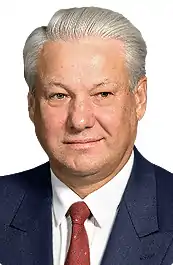
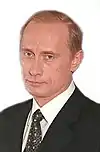
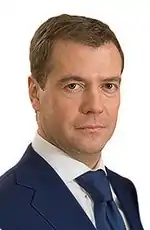
.jpg.webp)
.svg.png.webp)
